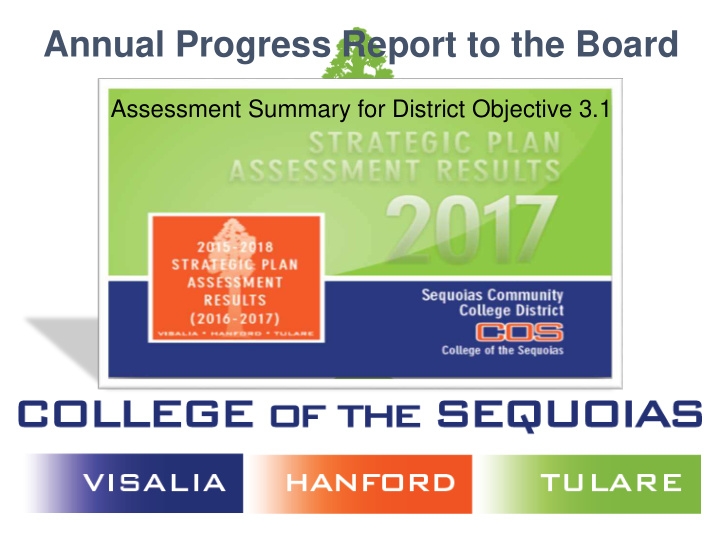



Annual Progress Report to the Board Assessment Summary for District Objective 3.1
Annual Progress Report to the Board September 10, 2018
Localizing Statewide Initiatives State Initiatives Dual Enrollment
District Goal #3: Current Snapshot District Objective 3.1: Reduce the achievement gap of disproportionately impacted student groups, as identified in the Student Equity Plan annually . DIG: Disproportionately Impacted student Groups
District Goal #3: Current Snapshot District Objective 3.1: Equity DIG Designation Comparison 200 African American students 178 149 continue to have the largest 153 126 (84%) 150 number of DIG designations (82%) compared to other student 100 groups. 50 13 18 14 11 (8%) (10%) (9%) (6%) 0 Total Number of Almost/At or Below Equity Far Below Equity Student Groups Above Equity 2016 Dataset (2009/10 Cohort) 2017 Dataset (2010/11 Cohort)
District Goal #3: Current Snapshot Equity District Objective 3.1:
Assessment Summary for District Objective 3.1
Assessment Summary for District Objectjve 3.1 District Objectjve 3.1 Reduce the achievement gap of disproportjonately impacted student groups annually, as identjfjed in the Student Equity Plan. Assessment of District Objectjve 3.1 Review and compare the following to the most current prior year data: Progress on metrics/measures identjfjed in the 2014 Student Equity Plan (Access, Course Comple- tjon, ESL and Basic Skills Completjon, Degree and Certjfjcate Completjon, Transfer, 30 - Unit Thresh- old, and Persistence) to the most current prior year data. Summary The majority of the student groups in the 2017 dataset performed At or Above Equity or Almost at Eq- uity (149/178). The 2017 dataset has slightly more disproportjonately impacted group designatjons (DIGs) (n=29) than the 2016 dataset (n=27). Of the 29 DIGs, 11 student groups performed Below Equity and 18 student groups performed Far Below Equity. The metrics with the largest number of DIG desig- natjons were Student Progress and Rate (SPAR) Certjfjcates (n=5), SPAR Degrees (n=4), and Access (n=4). The two student groups with the most DIG designatjons were African American and students with Two or More Races, with six designatjons each. Students with an unknown ethnicity had the next largest number of designatjons (n=5). It is important to note that a considerable amount of prescribed data, which the state requires the District to use, tracks student cohorts for six years, which means that the 2017 data are for a cohort that started at the District years before these Student Success Program strategies were started. Three - Year Summary For the past three years, the performance of three cohorts have been reviewed to determine each stu- dent group ’ s equity performance across multjple metrics that measure student achievement. Overall, the majority of student groups across all three cohorts performed Almost at Equity or At or Above Equity (390/473). A total of 83 student groups, from all three cohorts, were identjfjed as DIGs across a variety of metrics. 14
Analysis and Results 3.1 This following is a summary of the student populatjons from the 2017 dataset that were identjfjed as a Disproportjonately Impact- ed Group (DIG), per metric, according to the Equity as a Measure of Performance Matrix. Student populatjons with less than 20 students are not included in the analysis. Access Completjon SPAR African American: Far Below Equity Unknown Ethnicity: Below Equity American Indian/Alaskan Natjve: Far Below Equity Asian: Far Below Equity SPAR Certjfjcates White: Below Equity Female: Below Equity Gender Unknown: Far Below Equity Course Completjon African American: Far Below Equity Pacifjc Islander: Below Equity SPAR Degrees ESL Male: Below Equity Hispanic: Below Equity African American: Below Equity Two or More Races: Far Below Equity Math Unknown Ethnicity: Far Below Equity African American: Far Below Equity Two or More Races: Far Below Equity SPAR Transferred Prepared Unknown Ethnicity: Below Equity African American: Far Below Equity Two or More Races: Below Equity English Male: Below Equity SPAR Transferred to 4 - Year African American: Far Below Equity Disabled Students: Far Below Equity Two or More Races: Far Below Equity Transfer Velocity 30 - Unit Rate Unknown Ethnicity: Far Below Equity Two or More Races: Below Equity Disabled Students: Far Below Equity Economically Disadvantaged Students: Far Below Equity Persistence None 15
Analysis and Results 3.1 Source: Bensimon and Malcom - Piqueux, L., 2014; p.14.) The 2015 Student Equity Plan (SEP), which includes 13 metrics, 15 groups, and 26 Disproportjonately Impacted Group (DIG) designatjons, is more comprehensive than the 2014 SEP. The 2015 SEP has a rigorous evaluatjon plan with 15 Goal Evaluatjons, a robust assessment plan with 27 Ac- tjvity Assessments, and will serve as baseline data for the forthcoming years. Data collectjon for the evaluatjon and assessment plans is going to be an ongoing process. Summary of 2015 Student Equity Plan 15 Goals 15 Goal Evaluatjons 27 Actjvitjes 27 Actjvity Assessments 13 Metrics 15 Groups 26 DIG Designatjons Sources: Student Equity Plan 2014 Student Equity Plan 2015 2015 Student Equity Evaluatjon Plan 2015 Student Equity Assessment Plan Bensimon, E. M. & Malcom - Piqueux, L. (2014). Assessing ‘ Hispanic Servingness ’ at HSIs. The AAHHE Annual Conference “ Americas Prosperity: The Academic Success of Hispanics ” March 6 - 8; Costa Mesa, CA 16
Thank You!
Recommend
More recommend